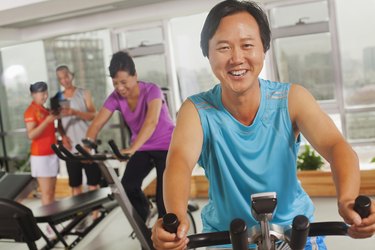
There's no doubt that using a stationary bicycle can help you get in shape, lose weight and even build muscle. When it comes to the speed at which you should be riding, though, that's all going to depend on your level of fitness and how hard you're willing to work. In other words, don't compare speeds with other people who may be using the same brand of bike; this is your fitness journey, and the only person you need to compete against is yourself.
An Alternative to Speed
Video of the Day
When you work out, you want to make sure you're exercising at an intensity that will produce results. Instead of focusing on your speed, try using what's called the "talk test," touted by researchers from the American Council on Exercise as a simple, yet highly effective way of determining how hard you're working out. Since it's tailored to your individual fitness level, it's more effective than naming a certain speed at which you should be cycling. It can also be more telling than monitoring your heart rate with the bicycle's heart rate monitor, since the "target" ranges on stationary bicycle computers are based on averages that may or may not be accurate for you.
Video of the Day
How to Do It
It's simple: If your heart is beating faster, your lungs are working harder, and you can talk comfortably -- but can't sing -- you are likely working out at a level that is ideal for improving your cardiovascular health and losing weight. When you get to the point where talking becomes even more difficult and you can't say more than a few words, you've reached another level of exercise intensity. That level is going to burn more calories and improve your performance, but it's more difficult to sustain for a long period of time. If you're pedaling that bike so fast that you can't speak more than a single word, you're probably won't be able to sustain it for more than a few minutes. As a general rule, aim for the "easy to talk" zone for longer exercise sessions, the "harder to talk" zone for shorter, faster sessions of 20 minutes or less, and the "really hard to talk" zone only very sparingly.